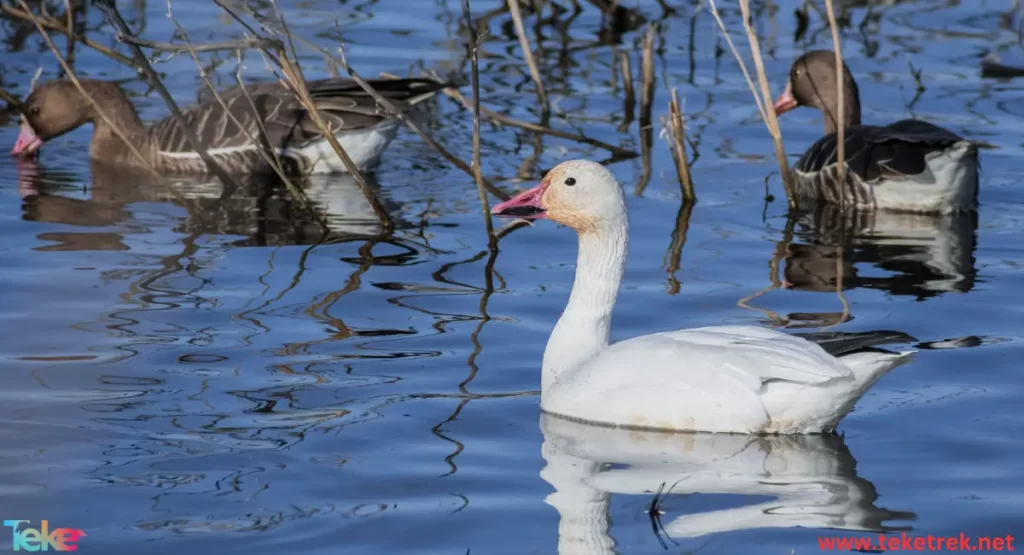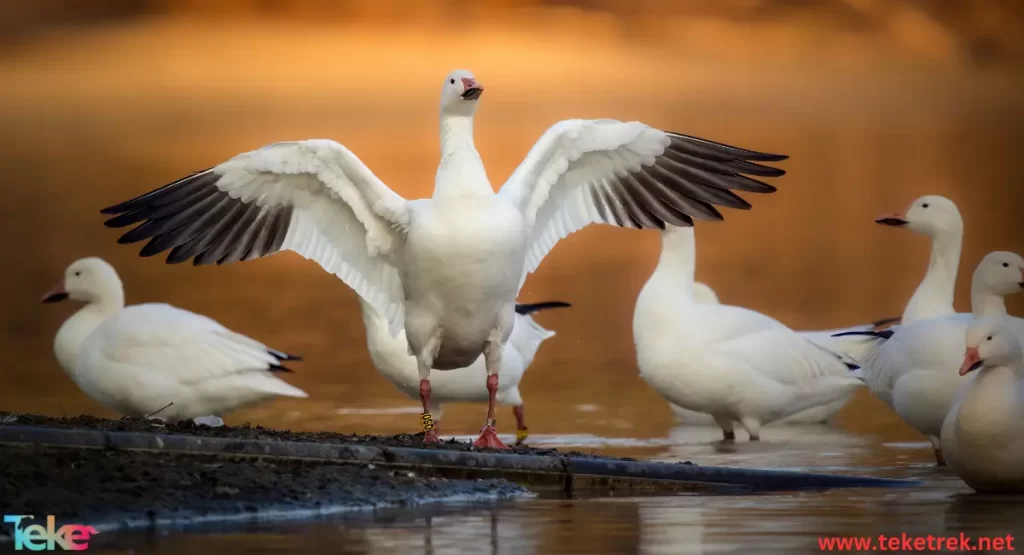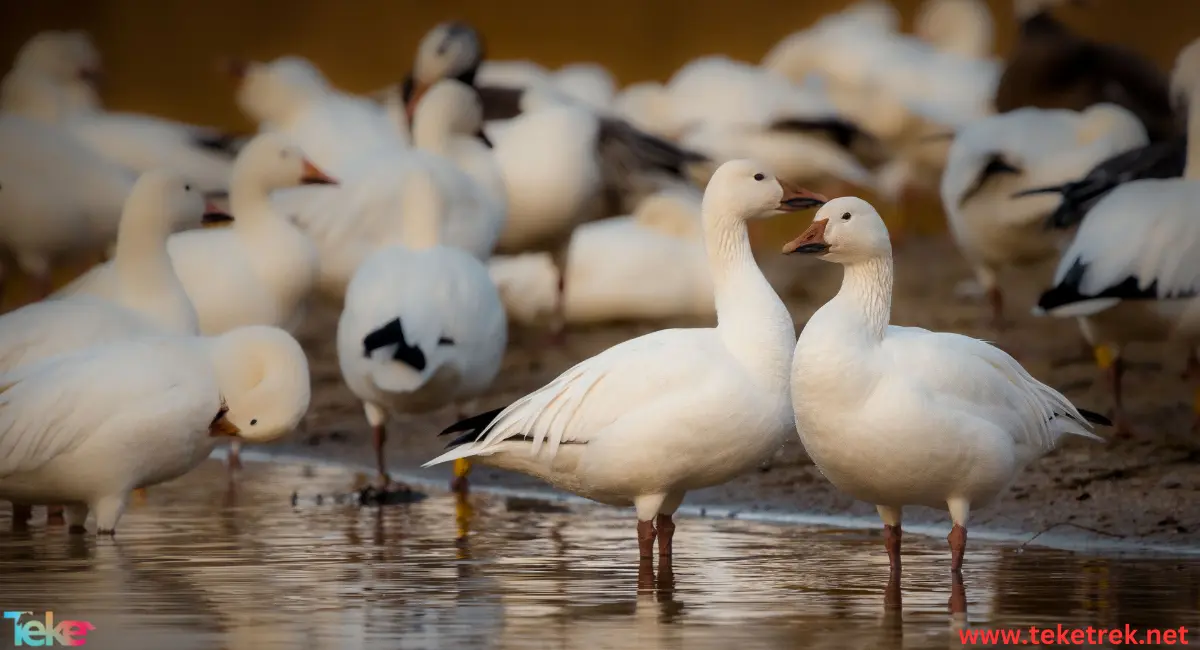Snow geese are one of the famous birds that live in the Arctic regions.
Snow geese, characterized by their oval appearance and thick white feathers, are considered one of the largest seabirds in the world.
Its wingspan reaches 1.5 m.
It is an essential part of the ecosystem in the polar regions, and plays an important role in the balance of the ecosystem. Today, we explore more about it from Tiki Trek.

About the snow geese
Snow geese, blue geese, or snow geese, are a type of geese found in North America. They were named after their snow-colored color.
Snow geese belong to the phylum Chordata, a class of birds.
Snow geese are an essential part of the ecosystem in the polar regions, and play an important role in the balance of the ecosystem.
Snow geese have amazing abilities that make them able to adapt to the harsh conditions in the polar regions, as these birds can survive at very low temperatures, and use their thick feathers as a means of thermal insulation to maintain their body heat.
Snow geese face many challenges due to climate change and degradation of their natural habitat.
The change in temperature levels and the decrease in the amount of ice in the polar regions is a major threat to the lives of snow geese and other living organisms in these regions, so we must raise awareness of the importance of protecting these birds and preserving their presence to ensure their continuity in the future.
Where snow geese are found
These birds are found primarily in the northern arboreal range of Canada, Greenland, Alaska, and the northeastern part of Siberia.
Snow geese are found in the winter in hot areas of North America, southwestern British Columbia and Mexico, and they can also be found in rare places in Europe.
Reproduction stages of snow geese
At the end of cold winters, snow geese fly from the north to breeding grounds in the Arctic tundra. These pairs mate and produce about 2-6 eggs each year in a shallow ground nest.
Young can swim on their own during feeding and within 24 hours, but accompany them in captivity in winter, and captivity can be identified as groups during both northern and southern migrations.
Favorite food of snow geese
Snow geese are vegetarians, feeding mainly on grains, grasses and grasses in their natural habitat. Their diet is also rich in fiber, vitamins and minerals that help them survive and grow.
Snow geese have a flat, wide beak that they can use to pick grasses and grasses from the water or from the ground. They can also eat some of the seeds and grains that are part of their diet.
Threats to snow geese
Climate changes, rising temperatures leading to the melting of ice, and deteriorating living spaces are among the most important things that negatively affect the lives of snow geese.
Other risk factors affecting snow geese include chemical pollutants and waste, poaching, habitat loss, environmental disturbances such as disease, nuclear testing, and extreme natural events.
Distinguish snow geese from other species?
Snow geese are distinguished by several characteristics that distinguish them from other species and from other birds. These characteristics include:
1. White color: Snow geese are considered one of the few types of birds that are characterized by a bright white color, which makes them easy to distinguish from other birds.
2. Habitat and environment: Snow geese are found in cold areas, swamps, and frozen lakes, which makes them fully adapted to this harsh environment.
3. Flat Beak: Snow geese have a flat, wide beak that they can use efficiently to pick grasses and grasses from the water.
4. Adaptive Flight: Snow geese have the ability to fly quickly and smoothly, even in extreme weather conditions.
5. Feeding habits: Snow geese depend on a vegetarian diet consisting mainly of grains, grasses, and aquatic herbs.

protect snow geese from threat and extinction:
Protecting and preserving snow geese from threats and extinction requires taking specific measures, and the most important measures that can be taken to protect snow geese are:
1. Preserving its natural environment: The swamps and frozen lakes in which snow geese live must be preserved, and not interfere with that natural environment in a way that negatively affects wildlife.
2. Pollution control: Measures must be taken to reduce environmental pollution, whether resulting from industries, agriculture or any other activity, as pollution can affect the quality of water and food available to snow geese.
3. Protecting environmental habitats: Special protected areas and natural parks must be established to protect snow geese and other wild animals that live in the same environment.
4. Awareness and education: It is a good idea to educate the community about the importance of protecting and preserving snow geese.
5. Conducting sustainable breeding programs: Programs can be implemented to raise snow geese in a controlled environment to ensure their continued presence and reproduction.
Certainly, there are more measures that can be taken to protect snow geese, and biodiversity and wildlife conservation efforts are important for environmental and human health.
In conclusion, we realize the importance of protecting snow geese and preserving the diversity of wildlife.
Snow geese are an essential part of the ecosystem in the polar regions, and play an important role in maintaining the ecological balance.
Therefore, we must all work together to protect these wonderful birds and preserve their natural environment.
Therefore, let us work together to protect snow geese and all forms of wildlife, and dedicate our efforts to preserving these wonderful creatures that enrich our lives and enhance the beauty of nature around us.
Let us all be part of this journey towards preserving the ecological balance and preserving our planet for future generations.





